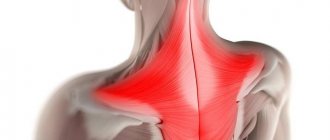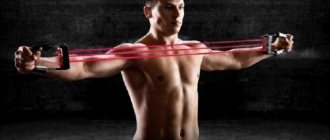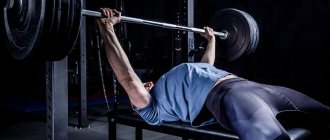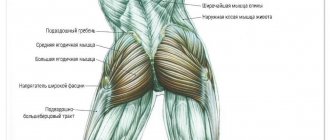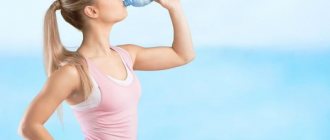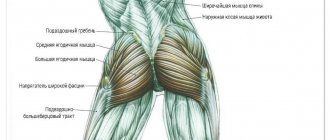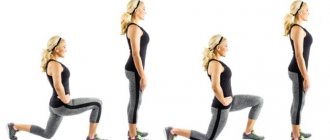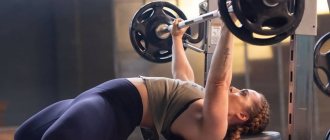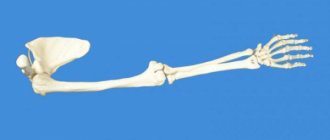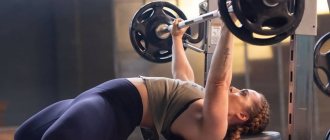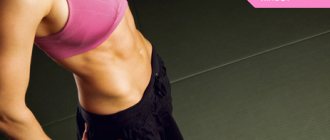The trapezius is a flat, broad muscle that is located at the very top of the back and forms the shoulders. It is part of the three largest muscles in the human body. It connects the latissimus dorsi and deltoids. Performs the following functions: adduction, abduction, elevation and descent of the shoulder blades. It is important to develop the trapezius muscles, as they form the posture of the spine in the cervical region, support the neck and relieve some of the load from it.
It must be remembered that the trapezius is indirectly involved in many exercises. Therefore, the main thing is not to overload this muscle area. Based on the fact that the trapezius is involved in the following exercises, correctly distribute the load across training days:
- military press
- dumbbell press up
- Bent-over barbell row
- dips
- horizontal block thrust
- vertical block thrust
- swings with dumbbells
We conclude that the load on the trapezius falls on all workouts where the upper body is involved. Therefore, it is better to use individual isolation exercises, for example, on leg day. And in order to quickly and efficiently build up trapezius muscles, it is necessary to take into account the following conditions: regularity of training, proper distribution of load, high-quality technical execution of exercises, proper nutrition, healthy sleep.
Parallel bars training
If you have parallel bars at home or on the street, you should diversify the set of exercises with exercises on the apparatus. In this case, pumping of the trapezoids is carried out according to the following scheme. Grasping the bars with your palms, the body is tilted parallel to the ground. From this position they stretch upward. At the top point, squeeze your shoulder blades tightly together. The chest is qualitatively opened, sticking out forward with a wheel. After pausing for a moment in this position, slowly move the body down.
After mastering the exercise, you can make the workout a little more difficult. During pull-ups, it is enough to press your knees tightly to your chest, crossing your legs at the shins. It is important to perform the work with increased amplitude.
Medium grip pull-ups
Many athletes believe that it is pull-ups with a medium straight grip that best work the deltoid muscle, which acts as an auxiliary muscle.
Here's how to do this exercise:
- In the starting position, hang on the horizontal bar and arch your back. To make the exercise a little easier, you can bend your knees and cross them. Since we are talking about a medium grip, place your hands shoulder-width apart.
- Now, smoothly, without jerking, begin to stretch upward, while trying to bring your shoulder blades together.
- The pull-up is considered complete if the chin is above the bar. But for maximum muscle development, it is recommended to pull yourself up until your upper chest touches the bar.
- After completing the pull-up, slowly lower yourself and fully straighten your arms at the bottom.
Inhale before performing the exercise and upon returning to the starting position, exhale during pull-ups.
Exercises to pump up the trapezius muscles
The trapezius muscle triangles are located on both sides of the spine. Their apices are directed towards the acromion of the scapula, the bases are directed towards the spine. The muscle on both sides has a generally trapezoidal shape. They develop the trapezius with exercises for its top, bottom and middle together with training of the muscular system of the back and shoulder delta.
Trapezius muscle in an athlete
The trapezius muscle consists of three functional independent areas - upper, middle and lower.
Before pumping up the trapezius, you need to decide on the equipment for training each of the areas, combining exercises with the development of other significant muscles on the back and shoulders. A properly selected complex can provide massive trapezius muscles and a sculpted torso and arms.
- The upper part of the muscle is trained with shrugs (raising and lowering the shoulders under load), for which a barbell and dumbbells are used. The projectiles should be placed in front of you, behind you and on both sides.
- The lower trapezius muscle is developed in conjunction with the shoulders by lifting weights overhead.
- The middle of the muscle is pumped up during bent-over rows during back training.
Full range of shrugs
Anyone who is trying to pump up their trapezius muscles does shrugs with dumbbells, a barbell, or in a machine. One of the typical mistakes is excessive weight, which reduces the already small range of motion. You often see people using a barbell or Smith machine just to get as many twenties on the bar as possible.
“Sometimes you see guys who put 200, 250 or 300 kilograms on the bar,” Capurso says. “As a result, their movements resemble muscle spasms rather than legitimate shrugs.”
Reducing the range of motion reduces stimulation of your trapezius, which is the stimulation that leads to muscle hypertrophy. Try to work as wide a range as possible, starting with a full trapezius extension at the bottom, then squeezing your shoulders and lifting them up until they are fully contracted. Capurso advises to mentally imagine the contraction as if you were trying to touch your trapezoids to your ears.
Partial repetitions of squats or leg presses will not allow you to reach the full potential of your thigh muscles. It’s the same story with trapezoids - only full amplitude can make them grow and develop. Yes, you are sacrificing working weight, but we are not in a shrug competition. The goal is to pump up the trapezius muscles.
How to train the upper and lower bun?
Training the upper trapezius muscle is done by simply shrugging your shoulders. This means that the shrug exercise and its variations are ideal for this. These are the simplest insulating complexes that perfectly distribute the load throughout the trapezoid, with a greater emphasis on the upper beam.
To train the lower trapezius, you can use basic multi-joint complexes that involve the entire back, or use reverse shrugs between surfaces (bars, stools, etc.)
Partial pull-ups
For one reason or another, some people cannot immediately perform full pull-ups. Partial exercise is ideal for them, which allows you to prepare your body for full pull-ups and, most importantly, work your shoulders.
Exercise technique
1) Grab the bar with a medium grip (hands shoulder-width apart), preferably with a reverse grip, that is, palms facing yourself.
2) In this case, the back should remain straight; to prevent swaying and make it easier to perform, the legs can be bent at the knees and crossed.
3) You need to pull yourself up not all the way to the horizontal bar, but approximately to the middle point (partial pull-ups).
4) When you have reached the midpoint, fix your body in this position and squeeze your collarbone, that is, tighten your deltoid muscle as much as possible.
In addition to the shoulders, this exercise develops the biceps.
Anatomy
The trapezius muscles, unlike the latissimus and rhomboids, are a large complex that normalizes the upper part of the spine. The complex can be divided into 3 main groups:
- Upper - in fact, this is what we are talking about when the appropriate exercises for the trapezius are prescribed. Responsible for raising the shoulders and keeping them in normal condition;
- The middle beam is located under the diamond-shaped ones. Easily activated using a deadlift. Responsible for the “thickness of the back” and bringing the shoulder blades back.
- The lower beam is responsible for bringing the shoulder blades closer to the spine. Usually functions simultaneously with the top one. But for pumping, separate sets of exercises are required.
And what does it mean? Yes, it’s simple - to properly develop the trapezius group, you need not one exercise, but three. A similar situation can be observed, for example, with the pectoral muscles, or to a lesser extent with the triceps.
Why are they needed?
A very relevant question for most athletes. If, regarding bodybuilders, the answer becomes obvious - “aesthetics”, then why pump the trapezius, for people who believe that deadlifts and upper rows provide sufficient load on the entire back.
- First, carry the girl in your arms. Yes, no matter how funny it may seem, even with very strong arms, it is simply impossible to beautifully lift a girl to carry her “to the altar.” It will hang below the level of the press, which will look very unaesthetic.
- Secondly, carry bags from department stores. Have you been working out in the gym for a long time? You're working hard and have already gained a couple of kilograms of weight, but how many bags of food can you carry? And we are not talking about the distance from the store to the trunk, but from the store to home. To ensure that carrying large loads does not cause stress, especially with prolonged static exposure, you need to work on your trapezius.
- Thirdly, appearance. A person who trains hard in the gym (on horizontal bars with uneven bars, does CrossFit, etc.) can get a huge imbalance between the pectoral and back muscles. Outwardly, this does not look very pleasant; it seems that the person constantly has a hunched back and low shoulders. Many people have seen this picture in the gym, but if you look closely at athletic professionals, none of them have drooping shoulders. And all because they are held by trapezoids.
On the subject: What muscles does the treadmill use?
Well, and finally – the quality and position of the spine. As you know, in order to get rid of the consequences of slouching, and even to maintain your back in a straight position, you need to train the spinal muscles. Sometimes a back brace can even deal with more serious injuries due to the pressure it creates. So, if you work exclusively on the lower back, without paying enough attention to the trapezius, there is a high risk of getting lordosis of the upper back and related diseases.
Contraindications
Effective trapezius exercises, first of all, have a positive effect on health. The first caveat is connected with this. If a person has severe spinal diseases (kyphosis, scoliosis, 1st degree lordosis), then doing shrugs and deadlifts is strictly prohibited. You should first consult a doctor to avoid injury and worsen the situation. Therefore, for a long time you will have to make do exclusively with pull-ups and hangs. Then, when the corset is already formed, you will need to undergo another examination and determine which weights are safe for the spine.
The second warning for those who decide to work out in the gym is to limit the progression of loads. Traps are designed in such a way that they progress in weights much faster than any other exercise. This may be associated with a reverse imbalance, when strong trapezius will raise the shoulders high, in turn this also harms the spine.
Well, the third warning for training the trapezius muscle is the presence of a torn lower back (no matter, micro dislocation, or simply overtrained by hyperextension), in this case you should always insure yourself by using a weightlifting belt
It is not recommended to perform barbell rows to the chin for people who have not fully mastered the technique or have problems in the shoulder joints, since part of the load falls on the deltoids, and at a very risky angle, which can lead to additional injuries.
Why pull-ups?
Why is it possible to pump up your shoulders well with the help of pull-ups? It's all about physiology.
Pull-ups can be compared to pressing a barbell up; in fact, the same movements are performed. And it is this movement that is the most convenient from the point of view of anatomy, therefore athletes cope with large weights when bench pressing and develop maximum strength, the muscles experience severe stress and receive a huge load, which leads to an increase in muscle mass.
When you do pull-ups, your elbows move out to your sides, this is exactly the work that the deltoid muscle does. For this reason, the range of motion should be maximum!
When you pull yourself up not from your chin, but until you touch the horizontal bar with your upper chest, your elbows drop as low as possible, due to which your shoulders are fully involved in the work.
Conquerors of sports grounds
Today, sports, body culture, and a healthy lifestyle are an important part and, to some extent, even fashion, among progressive youth. And that's great! Such a direction of the sports subculture as workout has gained great popularity.
You can often meet young people, participants in this progressive youth movement, on sports grounds, where they practice incredible somersaults or horizontal bars. And they can truly be considered the luminaries of the crossbar.
The video below contains a set of exercises on the horizontal bar to strengthen the muscles of the back and spine, which is used by workout representatives. Their strong, strong, toned bodies are direct proof of the effectiveness of the proposed training. Play sports and take care of your health. See you soon.
In order for you to have a beautiful, muscular and sculpted body, you don’t have to go to the gym. You can also pump up your back on the uneven bars.
, because they can be found in almost any yard or installed at home. Bars
- as usual, these are two crossbars or poles that are mounted on racks and are parallel to each other. Training on parallel bars takes place in a hanging position, so they need to be installed so that you do not touch the floor.
How to pump up a trapezoid without dumbbells and without any iron at all
Any girl and woman also wants to change their figure for the better, but here the focus is usually on slimness, lack of fat deposits and beautiful feminine forms.
All this can be achieved at home and without exercise equipment, but we must not forget about the uniform development of all muscles, including the trapezius.
Article on the topic: “Exercises for posture at home”
To pump up your trapeze at home, you will need a horizontal bar and parallel bars, which can be found in every yard. Of course, in 1 week you are unlikely to achieve significant results, but in a month they will be clearly visible.
The correct technique is of decisive importance, so in this article you will find relevant photos and videos - they will help you master the technique and demonstrate the main mistakes of beginners.
The best sports nutrition for weight gain
Tribulus
Agmatine Sulfate
L-Arginine (argenine)
Creatine
Glutamine
Exercise on the horizontal bar
You can pump up your trapezius on the horizontal bar, as this exercise allows you to quickly work out muscle fibers and is considered by instructors to be one of the most effective. To get the best results, it is recommended to perform pull-ups with a wide grip of your hands, that is, they should be positioned wider than your shoulders.
To increase the involvement of the trapezius muscles, it is recommended to strive to bring the shoulder blades together as much as possible when performing. It is worth making sure that the main load falls on the back and does not go to the biceps area.
The exercise can be performed in the traditional technique with the chest touching the horizontal bar, or you can use a variation and touch the horizontal bar with the back of your head.
Notes and tips on technique
To avoid injury, do everything correctly and load exactly the muscles you need, read the following tips:
- Before doing trapezius exercises, pay attention to your posture. Stand up straight, don't slouch, straighten your shoulders. Make sure your posture is correct. If necessary, go to the wall and press your back against it. With good posture, the walls will touch the back of your head, shoulder blades, buttocks and elbows.
- Watch your elbows. They must stay ahead of the bar, always be higher. Try not to let them come forward.
- Do everything smoothly. Snatching won't help you pump anything up, but it will increase your risk of injury.
- Warm up well. Shoulders are the weak point of any person. Always start the exercise with a light weight. Do a warm-up approach. And at the beginning of the workout, warm up your joints and ligaments well. It will take you 5 minutes, but will dramatically reduce the risk of injuring yourself.
- The trapezius muscle is very strong. Handle scales carefully.
Bent-over dumbbell row
To perform the trapezius muscle exercise, you will need a stable chair or bench. Place your straightened arm on the prepared surface with your palm. The second point of contact is the knee. Slightly pull in the stomach, tilt the straightened back in the frontal direction. With your free hand, grab a moderately heavy dumbbell. The limb begins to be slowly pulled up, bending at the elbow. At the end point the projectile must touch the side of the body. The dumbbell is slowly lowered to the bottom position, straightening the arm. Perform a series of repetitions on one side. Change position. Then they do an exercise with dumbbells on the trapezius muscle, pulling the projectile towards the body with the other hand.
Functions of a trapezoid
The trapezius muscle diverges symmetrically on both sides of the upper part of the spinal column, attaching at the top to the cervical vertebrae and occipital bone. The muscle fibers of the middle part of the trapezius are attached to the outer edges of the collarbones and scapular bones, and the fibers of the lower part are attached to the shoulder blades.
Since different parts of this large superficial muscle are attached to different bones, then, accordingly, the function of the trapezius muscle is determined by the totality of the functions of each of its parts. The upper part of the trapezius is responsible for raising the shoulder girdle upward and is involved in raising the arms. The lower trapezius muscle is responsible for lowering the shoulder girdle and is involved in lowering the arms. And the middle zone of the trapezius ensures the reduction of the shoulder blades.
Mid-trapezoid exercise. Exercises for home
- Boat. The exercise targets the trapezius with an emphasis on the middle and lower parts. The emphasis of the load can be changed by changing the position of the hands. The technique is illustrated in the photo.
When you direct your hands in front of you, the middle and upper parts receive the load to a greater extent. When the arms are directed perpendicular to the body, the middle of the trapezius is most involved. If you move your arms back, the emphasis will shift to the lower part. When performing the exercise, bring your shoulder blades together. Do 3-4 sets of 10-12 reps
- Push-ups with a raised pelvis. An effective exercise for the lower trapezius. Make sure your back is straight while moving. Your legs can be slightly bent at the knees. Your arms should work as if you were doing regular push-ups. Perform 3-4 sets of 10-12 repetitions.
For a fruitful home workout, it would be a good idea to exercise with a pair of dumbbells or kettlebells. They will make a significant contribution to the development of your trapezius. But there is a way to solve the problem without significant costs - train with an expander!
- Shrugs with an expander. The movement works best on the top of the trapezius. To begin, stand in the starting position as in the picture.
Then pull your shoulder girdle up, you should aim to pull your shoulders as close to your ears as possible. When performing the exercise, keep your back straight and do not tilt your head down. Also avoid rotating your shoulders, as some “masters” do in the gym. Perform 3-4 sets of 10-15 repetitions.
- Raising your arms back with an expander. The exercise uses the trapezius with an emphasis on the middle. Be sure to squeeze your shoulder blades together as you perform the movement. Do 3-4 sets of 12-15 reps.
- Standing presses with an expander. The main burden falls on the shoulders. But as I already said, the trapezius grows in conjunction with other muscles. In this case, the bottom of the trapezoids will receive its portion of the load. Perform 3-4 sets of 10-12 repetitions.
Shrugs with a barbell
First exercise.
Designed for training the upper trapezius. With its help, a powerful, pronounced upper back is formed, which makes the male figure massive. When performing this exercise, be sure to keep your head upright, secure your elbows, legs and body. Movements are performed only by the trapezius muscles. Stand up. Place your feet shoulder-width apart and bend your knees slightly. Grasp the barbell with an overhand grip that should be shoulder-width apart.
Straighten up (chest should be straightened, arch in the lower back). Hold the staff on straight arms.
As you inhale, pull your shoulders up, trying to reach your ears with your shoulders. Hold at the highest point for 2 seconds, tensing the trapezius muscles as much as possible.
Exhale and smoothly, without jerking, return to the starting position, lowering your shoulders.
This exercise must be performed at the very beginning of trapezius training, 4 sets of 10 repetitions. The goal here is to raise your shoulders as high as possible while keeping the rest of your body still. You cannot rotate your head or shoulders during the exercise, as this can cause injury.
Second exercise. It consists of raising the barbell to the chin. In this exercise, the upper and middle trapezius and middle deltas contract. With its help, muscle relief is created and the trapezius is separated from the delta. Elbows should look to the sides and move only in the plane of the body. The grip width is less than shoulder width.
The wider the grip, the more load will go into the deltoids; the narrower it is, the more the trapezius will be strained. While performing this exercise, you need to monitor your back position and posture. The abdominal muscles should be constantly tense.
Take the barbell with an overhand grip and stand straight. Hands in the starting position are straightened at the elbows. The bar touches the hips.
As you inhale, tighten your trapezius and neck muscles, spread your elbows and pull them up. The bar slides along the body from the hips to the chin. Stay at the top point, tensing the working muscles as much as possible. The elbows at the top should be higher than the shoulders.
Exhale and return to the starting position.
The exercise should be performed slowly, without jerking. The main rule here is that the elbows should constantly look to the sides and rise strictly in the plane of the body, vertically. To do this, the weight on the bar needs to be moderate so that it can be controlled.
Bent-over dumbbell row shrugs
Bent-over dumbbell rows work all the back muscles, as well as the rear deltoids. By introducing shrugs into this basic exercise, we get, in addition to everything, an increased emphasis on pumping up the trapezius. The classic dumbbell row technique is well known to everyone:
- Place one arm and leg on the support, giving your body an inclined position. Bend at the waist; under no circumstances should you round your back.
- Take a dumbbell in your free hand. Next, you should row the dumbbell upward by bending your elbow. The distribution of the load on the muscles will depend on the position of the elbow in relation to the body and on its trajectory upward, so perform the version of this exercise that suits your tasks.
- However, do not forget that we decided to complicate this exercise by introducing an element such as shrugs. This is done like this: before you start the dumbbell row, pull your shoulder as high as possible and only after that do the row, maintaining this shoulder position throughout the entire movement cycle.
- Only after lowering the dumbbell down, lower your shoulder and relax.
You will feel how much more efficiently the trapezius is loaded when performing this type of deadlift. This version of the dumbbell row allows you to work out the muscles involved in this exercise, and as a bonus, pump up the trapezius muscle to the desired volume.
What is the secret to a successful workout?
To perform an exercise on the trapezius bar, you need to learn how to pull yourself up correctly.
Particular attention should be paid to the technique of movements, bringing it to perfection, and after that you can increase the number of repetitions. For beginners, we advise you to first study how to create a training program on the horizontal bar for beginners
Slowly rise and fall without jerking, keeping track of the time of each movement (it should be approximately equal). Do not forget to monitor your breathing: exhale when exerting force, and inhale during the negative phase. Between approaches you need to take a short break - no more than 2 minutes.
Muscles need to recover, but if you rest too long between exercises on the trapezius bar, the effectiveness of the entire workout will be significantly reduced.
Bent over press
Sitting on a flat surface, lift dumbbells 8-10 times, pausing slightly at the bottom before each subsequent action. The effort should be made while exhaling, relaxing while inhaling. This way the motor impulse is completely absorbed, so you have to make an effort to get it again. Symptoms of fatigue and mild overexertion may be present, but there is no cause for concern.
How to download individual parts
Each department can be worked on separately. This should only be done if some part of the trapezoid is noticeably behind.
There is such a pattern:
- The middle trapezius works best during various types of deadlifts.
- The lower part - while lifting the apparatus above the head and in parallel when training the shoulders.
- The upper body is most effectively worked by shrugs - with barbells, dumbbells or on block-type exercise machines.
It is the upper section that is considered the most “indicative” for bodybuilders, because it gives power not only to the back, but also to the shoulders.
Best exercises
Barbell row to the chin in a standing position
This exercise works the trapezius, forearms, shoulders and upper back muscles.
I.P. - Feet shoulder-width apart, barbell with arms fully extended and arms lowered. A narrow grip is used, with your palms facing you, since a narrow grip loads the trapezius muscles much better.
As you inhale, pull the barbell to your chin. In this case, at the top point, the elbows should be higher than the wrists. Slowly, as you exhale, lower the barbell to its original position without jerking.
You should not lift the apparatus above your chin - this does not relieve the load on the trapezius muscles and interferes with the normal mechanics of our body.
The barbell lift is more effective compared to machines such as the Smith machine and the pulley machine.
Free weights stimulate the work of stabilizer muscles throughout the entire movement, and this is beneficial for the normal functioning of all muscle fibers.
When performing this exercise, try to keep the apparatus as close to your body as possible. Muscle fibers should be fully stretched and contracted at the top and bottom points.
How to perform this exercise with a narrow grip is shown in the video:
Shrugs with a barbell in lowered hands
This exercise also works the trapezius, forearms, shoulders, and upper back. Before starting the exercise, you should set the stand to a comfortable height.
I.P. - feet stand shoulder width apart. Remove the bar from the racks with your arms fully extended. The back is straightened, you should ensure that the spine is in a straight position at all times.
As you inhale, raise your shoulders as high as possible, while your arms are also fully straightened. As you exhale, slowly lower the barbell to its original position, fully stretching your trapezius.
It is important to maintain a range of motion and fully contract and stretch the muscles with each repetition. This exercise is very simple, but at the same time, the most effective for the development of trapezius muscles.
When performing movements, do not rotate your shoulders, as this can lead to injury. No extraneous movements are needed: the weight should rise strictly up and fall strictly down.
Shrugs with dumbbells with arms down
This exercise works the trapezius, forearms, shoulders, and upper back. I.P. - feet shoulder-width apart, and arms with dumbbells are lowered freely along the body, the abdominal muscles are tense, the back is straight, the lumbar region is maximally tense. The spine is straight.
As you inhale, your shoulders rise as high as possible, almost touching your earlobes. As you exhale, the arms with the apparatus slowly return to their original position, while the trapezius is fully stretched.
You should carefully take the apparatus from the floor and return it to its place at the end of the exercise, sitting down and using only the strength of your leg muscles.
The muscles should be fully stretched and contracted with each repetition. The maximum amplitude should be maintained and incomplete repetitions should be avoided.
Shrugs with a barbell behind your back
This exercise helps to develop correct posture and form a muscle corset, which is necessary not only in sports, but also in everyday life as the main factor in the prevention of diseases and injuries of the spine. When performing it, the upper trapezius, shoulders and forearms, as well as the upper back are worked.
I.P. - stand up straight, put your feet shoulder-width apart and bend your knees slightly. Your partner should carefully give you the barbell from behind. It should be taken with an overhand grip, with the palms facing back, the distance between them slightly wider than the shoulders.
Straighten your back and pull your shoulders back, while you need to slightly lift your chest and pull in your stomach. Make sure your spine maintains its natural curves.
The arms are fully straightened behind the back. The bar is at the level of the lower buttocks. Look straight ahead. As you inhale, raise your shoulders as far as possible. The arms are straight throughout the entire movement. Only the shoulders work, and the back, legs and chest are motionless.
At the top point of the trapezius, you should tense as much as possible, maintaining this body position for several seconds to achieve the best effect. As you exhale, gently lower your shoulders.
To strengthen the trapezius muscles, select a weight commensurate with your capabilities, remember to change it to a heavier one as you develop muscle strength and endurance.
And then you can watch a video on how to quickly and correctly pump up your trapezius muscles with dumbbells in the gym or at home:
Recommendations for training the trapezius
- Shrugs are rightfully considered the best exercise for developing the trapezius, but many athletes do them incorrectly. You cannot use your biceps and forearms. Wrist straps help to cope with this very well. The elbows should be almost completely straight throughout the entire approach, then the load will be placed specifically on the trapezius.
- Don't use too much weight. When training the trapezius muscles, it is much more important to work in full amplitude and feel the maximum muscle contraction at the top point, holding it for 1-2 seconds.
- Do not tuck your chin to your chest when doing shrugs. This increases compression of the cervical spine and can lead to injury.
- Trapezius loves pumping. To properly “pump” these muscles with blood, use supersets, combining shrugs of any variation with pulling movements that also include the shoulders in the work, for example, with a close-grip chin row. Another option for increasing intensity is to perform dropsets at the end of each set: reduce the working weight and, without rest, do another set or two with a lighter weight.
- Trapezius is a relatively small muscle group; it is enough to train it once a week. It is optimal to combine it with back or shoulder training. To make the entire shoulder girdle look massive, do not forget to pay enough attention to your deltoids and neck muscles. If you notice that the trapezius has begun to overtake the shoulders in development, which visually makes the figure less wide in the shoulder girdle, just stop doing individual exercises for this muscle group.
- Trapezius training should be short but intense. As a rule, one or two exercises are enough to work this muscle group. Alternate different movements in each workout and perform them in different orders, then you will make progress faster.
- Watch your posture. Often, stooping in the cervical and thoracic spine prevents the trapezius from being fully trained. The athlete simply cannot perform the required movement in full amplitude and feel the muscle contraction.
- Exercise moderately. Overtraining of the trapezius muscles will lead to poor blood circulation in the neck muscles and the entire cervical spine. This is fraught with increased intracranial pressure, headaches and dizziness.
- Performing shrugs does not involve rotating the shoulder joints at the top point. For some reason, many novice athletes are guilty of this. When used with heavy weights, this rotation becomes one of the most damaging movements for your rotator cuff. The correct trajectory of movement involves raising and lowering the weight in one plane; there should be no extraneous movements.
Trapezius muscle. Structure and functions
The trapezius muscle (lat. musculus trapezius) is a flat, wide muscle that occupies a superficial position in the back of the neck and in the upper back.
The trapezius muscle is located in the upper back. Its size makes it clear whether a person does strength training or not. As the size of the trapezius increases, the size of the neck increases, and the strength and power of this muscle is of great importance in many pulling exercises and in various sports.
For example, by increasing the weight in shrugs, you thereby strengthen the muscles “responsible” for the upper phase of the deadlift in any of its variations (when you need to pull your shoulders back more). This will help you improve in the deadlift itself.
Overdeveloped upper and middle traps visually narrow your shoulders, so you shouldn’t train them separately. This muscle group works well in many exercises and this is enough for its growth.
The structure of the trapezius muscle
The trapezius muscle has the shape of a triangle, with its base facing the spinal column and its apex facing the acromion of the scapula. The trapezius muscles of both sides of the back together have the shape of a trapezoid. For those who have not yet understood, let me explain that there are two triangles, one on the left and the other on the right. See the picture.
From an anatomical point of view, the trapezius muscle is divided into 3 parts:
- upper (in the neck area)
- middle (top of shoulder blades)
- and lower ((between and under the shoulder blades)
Upper trapezoid
When people talk about the trapezius, they usually mean the upper part of the trapezius, as this is the area that most trapezius exercises target. The upper trapezius rotates, leads to the spine, elevates and depresses the scapula (the movement when you shrug your shoulders), and assists in most movements of the head and neck.
Postural problems, such as a persistent forward head posture (slouching), can lead to chronic tension in the upper trapezius muscle in a stretched state, which can result from both headaches and pain in the cervical spine.
In this case, you should avoid exercises that target the upper trapezius muscle.
Middle and lower trapezius
The middle and lower trapezius are worked in back exercises such as horizontal rows or rowing.
This area of the trapezius, together with the rhomboid muscles, is responsible for adducting the scapula towards the spine. The rhomboid muscles are not visible in the figure, since they are located deeper, that is, closer to the center of the body compared to the trapezius muscle.
Bringing the shoulder blades together is of great importance for stabilization and correct biomechanical position of the body during exercise. Which in turn will allow you to perform the exercises technically correctly and as efficiently as possible.
Trapezius muscle function
The trapezius muscle brings the scapula closer to the spinal column, contracting with all the bundles, raises the scapula, contracting with the upper bundles, and lowers, contracting with the lower ones.
When you try to cover your ears by shrugging your shoulders, you are using the trapezius muscles.
Anatomical characteristics
The trapezius muscle has the shape of a triangle, stretching along the vertebrae to the neck and shoulder.
This is a fairly large muscle, so it is divided into three sections according to location.
These include:
- upper section - located along the cervical spine;
- middle - located between the shoulder blades;
- lower - in the area under the shoulder blades.
The trapezius has the most tendons; according to this indicator, it is the record holder among the muscles of our body.
Tendon bundles are short in length, have a complex arrangement and stretch from:
- protrusion of the back of the head;
- medial third of the superior nuchal line of the occipital bone;
- nuchal ligament;
- spinous processes of the seventh cervical vertebra;
- supraspinous ligament.
All ligaments converge at the junction of the humerus and scapula. Most often, it is the upper part of the trapezoid that is subject to pumping.
This muscle is innervated by the processes of the accessory section and the cervical plexus (third-fourth pair).
The trapezius muscle is multifunctional.
It does the following:
- Brings the scapula and spine closer together.
- Raises, lowers and rotates the scapula by contracting various fascicles.
- Extends the neck, participates in tilting the head back.
- Turns the head during unilateral contraction.
The complex structure determines the many functions it performs.
And in anatomy there is such a law: the more complex the system, the more unstable and fragile it is. This must be taken into account during training to avoid injury.
Creating a training program
When creating a program, be sure to include several shoulder exercises on the horizontal bar and uneven bars of varying difficulty. If a person is in poor physical shape, then doing only simple push-ups or pull-ups is enough. If you can’t do push-ups from the parallel bars, then at first you can train your delta and chest by doing push-ups from the floor.
Among the main nuances of drawing up the program are:
- One workout should not include more than 5 exercises. In this case, basic movements must be present.
- As soon as the number of pull-ups exceeds 15, you can start adding weights. The same rule applies to bars.
- To increase muscle and shoulder width, it is recommended to choose technically simple, but physically challenging activities.
The main answer to the question of how to pump up your deltoids and back on the horizontal bar is a constant progression of loads. The load can be placed in a backpack or attached to a special belt. At first, simple water bottles can act as weighting agents. In the future, it is permissible to use weights or pancakes.
The number of repetitions should vary from 8 to 15 times. The number of approaches to pump up your shoulders is 3–5. You need to rest between approaches from 1.5 to 3 minutes. If progress slows down or stops completely, you need to change your training program.
If previously classes were conducted in a strength style, you will need to add more repetitions. If the training, on the contrary, was aimed at increasing endurance, then it is worth working in strength mode.
For constant progress, you need to regularly surprise your muscles.
The horizontal bar is an excellent and affordable solution. There are practically no contraindications to pull-ups. Even exercising 2 times a week will allow you to change your appearance and maintain excellent physical shape.
One workout does not include more than 5 exercises. Add weights as soon as the number of pull-ups exceeds 15. To increase muscles and shoulder width, opt for technically simple, but physically challenging activities.
Diet and training regimen
Combining proper nutrition and exercise is quite a difficult task. Success in achieving your goal depends on your diet and exercise routine. Therefore, it is worth motivating yourself in this. After you wake up, you should drink a glass of water and have breakfast 15-30 minutes later. Breakfast should be the heaviest of all subsequent meals.
In addition, a morning meal is the best way to convert nutrients into energy rather than fat. If there is no feeling of hunger in the morning, you should reduce your evening meal, so that you will have an appetite in the morning.
Before going directly to the gym or other physical activity, you should eat no later than two hours in advance, especially foods made from protein foods, which include meat, legumes, and dairy products. You should also remember that after playing sports you should not eat for at least two hours, and you are only allowed to drink water.
Eating carbohydrates is an essential component of fitness recipes and proper and healthy nutrition. Carbohydrates are simple and complex. To avoid gaining weight, you should start consuming exclusively complex carbohydrates. They can be found in cereals and legumes, in pasta, but only in hard varieties.
The listed products contain glucose in addition to carbohydrates. Simple carbohydrates are very harmful to your figure, because they are found in sweets, flour products and carbonated drinks, and they cause weight gain and a thinner figure.
